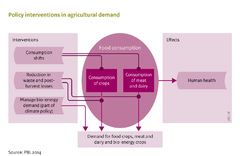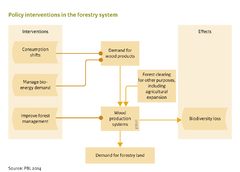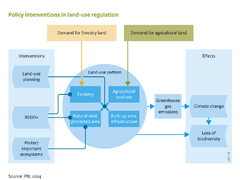Land and biodiversity policies: Difference between revisions
Jump to navigation
Jump to search
m (Text replace - "Agricultural systems" to "Land-use allocation") |
Oostenrijr (talk | contribs) No edit summary |
||
| (5 intermediate revisions by 2 users not shown) | |||
| Line 3: | Line 3: | ||
|Overview=Policy interventions overview; | |Overview=Policy interventions overview; | ||
|KeyReference=PBL, 2010; PBL, 2011; PBL, 2012; | |KeyReference=PBL, 2010; PBL, 2011; PBL, 2012; | ||
|Description=The wide range of environmental issues related to agriculture and forestry include distorted nutrient balances, biodiversity loss, greenhouse gas emissions from land use and land-use change, soil degradation, and water stress due to agricultural water demand. These issues can be addressed from a sector perspective focusing on the respective system (e.g., [[ | |Description=The increase in material wealth, population and economic growth have led to a large demand for agricultural products and transformation of large parts of the land surface. The wide range of environmental issues related to agriculture and forestry include distorted nutrient balances, biodiversity loss, greenhouse gas emissions from land use and land-use change, soil degradation, and water stress due to agricultural water demand. These issues can be addressed from a sector perspective focusing on the respective system (e.g., [[Nutrients|nutrients]], [[water]], see the respective components). However, these issues are linked by demand for land-based products, and by land management. | ||
The IMAGE framework enables a systems approach to analyse policy interventions targeting the impacts of land use on biodiversity and climate change. To identify interventions that could reduce the impacts of agriculture and forestry on the environment, the system takes account of the chain linking demand for food, feed, wood, and bioenergy, to types of production systems and to landscape impacts. | The IMAGE framework enables a systems approach to analyse policy interventions targeting the impacts of land use on biodiversity and climate change. To identify interventions that could reduce the impacts of agriculture and forestry on the environment, the system takes account of the chain linking demand for food, feed, wood, and bioenergy, to types of production systems and to landscape impacts. | ||
| Line 16: | Line 16: | ||
Policies that change demand for agricultural products ([[Land and biodiversity policies/Agricultural demand|Agricultural demand part]]) are implemented in the agricultural economic model, thus taking into account the impacts on trade and demand in other regions. In IMAGE 3.0, change in wood demand is addressed in the model via a simple relationship with GDP, or by using external input data on wood demand (see Component [[Agricultural economy]]). Demand for second-generation bioenergy crops is addressed in the [[Energy supply and demand|energy model]]. | Policies that change demand for agricultural products ([[Land and biodiversity policies/Agricultural demand|Agricultural demand part]]) are implemented in the agricultural economic model, thus taking into account the impacts on trade and demand in other regions. In IMAGE 3.0, change in wood demand is addressed in the model via a simple relationship with GDP, or by using external input data on wood demand (see Component [[Agricultural economy]]). Demand for second-generation bioenergy crops is addressed in the [[Energy supply and demand|energy model]]. | ||
Changes in production systems ([[Land and biodiversity policies/Agricultural production system|Agricultural production system part]]) are modelled in IMAGE using alternative input parameters. For the relevant inputs in e.g. the [[Land-use allocation|land-use allocation]], [[Livestock|livestock]], and [[ | Changes in production systems ([[Land and biodiversity policies/Agricultural production system|Agricultural production system part]]) are modelled in IMAGE using alternative input parameters. For the relevant inputs in e.g. the [[Land-use allocation|land-use allocation]], [[Livestock systems|livestock]], and [[Nutrients|nutrient]] modules, these changes are consistent with those in the [[Agricultural economy|agro-economic]] model, to ensure appropriate representation of the (cost) structure of production. Production system changes, for example those induced by taxes or scarcity of endowments, are implemented in the agro-economic model and adjusted in other modules, accordingly. | ||
Land-use regulation ([[Land and biodiversity policies/Forestry sector|Forestry sector]] and [[Land and biodiversity policies/Land-use regulation|Land-use regulation]] part), which is the regulation of land supply, is modelled as a consistent resource constraint in the [[Land-use allocation|land-use allocation]] model and the [[Agricultural economy|agro-economic model]]. This last model takes account of the economic effects of restricted land supply. For example, {{abbrTemplate|REDD+}} and {{abbrTemplate|PES}} are implemented not as additional productive functions, but by reducing the land supply in the agro-economic model. The spatial dimension of such land-use regulation, like the expansion of protected area, is taken into account in the [[Land-use allocation|agricultural systems]] module, and affects via the resulting land use pattern all down-stream processes. | Land-use regulation ([[Land and biodiversity policies/Forestry sector|Forestry sector]] and [[Land and biodiversity policies/Land-use regulation|Land-use regulation]] part), which is the regulation of land supply, is modelled as a consistent resource constraint in the [[Land-use allocation|land-use allocation]] model and the [[Agricultural economy|agro-economic model]]. This last model takes account of the economic effects of restricted land supply. For example, {{abbrTemplate|REDD+}} and {{abbrTemplate|PES}} are implemented not as additional productive functions, but by reducing the land supply in the agro-economic model. The spatial dimension of such land-use regulation, like the expansion of protected area, is taken into account in the [[Land-use allocation|agricultural systems]] module, and affects via the resulting land use pattern all down-stream processes. | ||
|PITable=No | |PITable=No | ||
|ISGroup= | |ISGroup= | ||
|IMAGEComponent=Climate policy; Air pollution and energy policies; Forest management; Agricultural economy; Land-use allocation; Livestock; Energy demand; Energy supply; | |IMAGEComponent=Climate policy; Air pollution and energy policies; Forest management; Agricultural economy; Land-use allocation; Livestock systems; Energy demand; Energy supply; Nutrients; Water; Crops and grass; | ||
|ComponentCode=LBP | |ComponentCode=LBP | ||
|FrameworkElementType=response component | |FrameworkElementType=response component | ||
|AggregatedComponent=Policy responses | |AggregatedComponent=Policy responses | ||
}} | }} | ||
{{#default_form:PolicyResponseComponentForm}} | |||
Revision as of 10:45, 6 June 2017
| Relevant overviews |
Key policy issues
- How can land-use policies contribute to strategies for halting biodiversity loss and reducing greenhouse gas emissions?
- How can changes in consumption patterns contribute to achieving sustainability goals through changes in land use?
- What are the synergies and trade-offs between halting biodiversity loss, food security, reducing nutrient emissions, and reducing water stress?
Introduction



